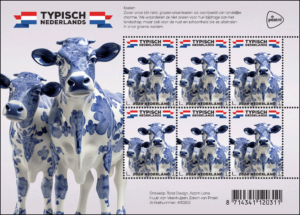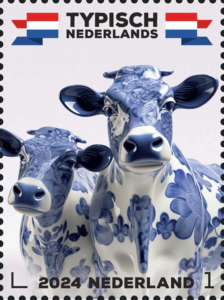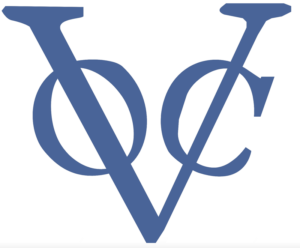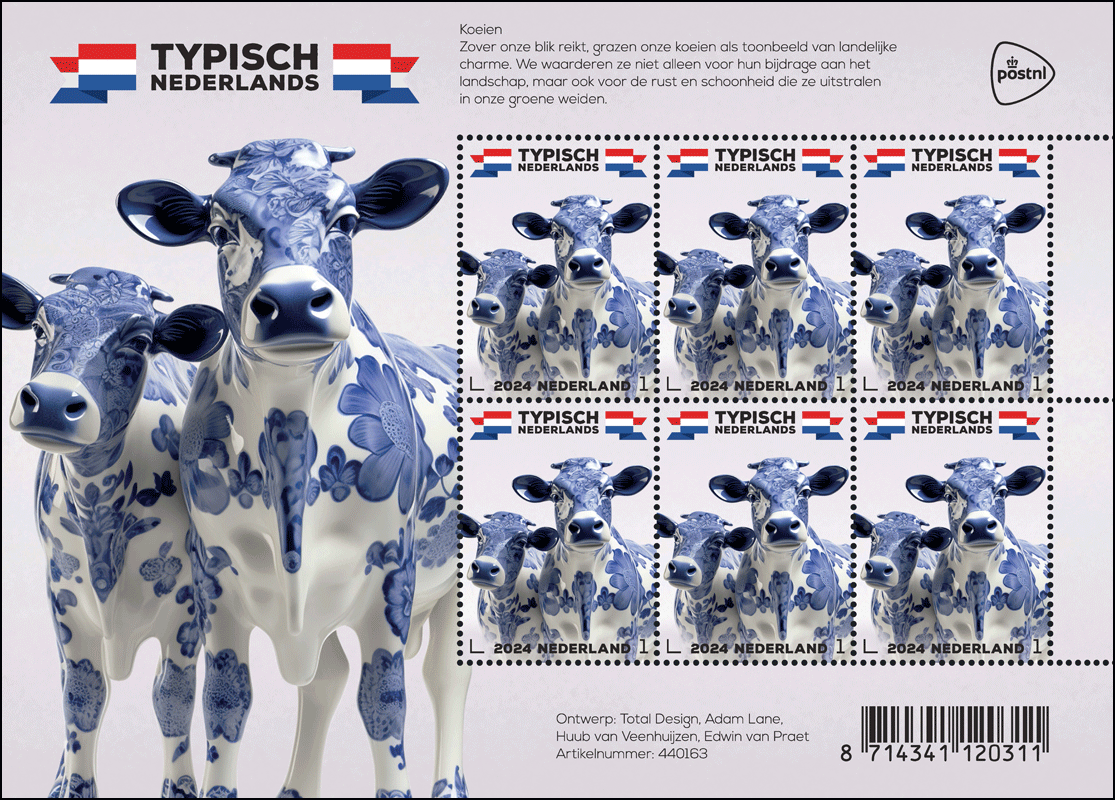[from PostNL press materials and other sources] [click on any of the pictures for larger versions]
Typically Dutch – Cows
 Date of issue: 2 January 2024
Date of issue: 2 January 2024
Appearance: sheet of six stamps in six identical designs
Item number: 440163
Design: Adam Lane, Edwin van Praet and Huub van Veenhuijzen from Total Design, Amsterdam
On 2 January 2024, PostNL will issue the Typically Dutch – Cows stamp sheet. This issue is the first in the Typically Dutch series this year. The multi-year series was launched in 2020 and the 2024 edition is dedicated to the animals that we know best and that are closest to us. The six identical postage stamps will be marked ‘Nederland 1’, the denomination for items weighing up to 20g destined for the Netherlands. A sheet of ten stamps costs €6.54 [currently US$7.21].
Typically Dutch – Cows was designed by Senior Graphic Designer Adam Lane, Executive Creative Director Edwin van Praet and Concept Director Huub van Veenhuijzen from Total Design in Amsterdam. They used artificial intelligence to create a design featuring figurines in the shape of Delftware pottery. Later on this year, the Typically Dutch series will continue with the following subjects: dogs (12 February), horses (25 March), songbirds (13 May) and cats (12 August).
 Cows: Cattle have long been kept by humans as pets – probably for over 10,000 years. Long-term domestication and breeding programmes have resulted in many different breeds. Cattle are descended from the aurochs, a wild bovine that became extinct in the Middle Ages. For humans, cattle farming is now one of the main sources of meat, milk and leather. Cattle terminology is as follows: a female bovine is called a cow, a male bovine is called a bull, a young bovine is called a cow calf or bull calf, a yearling is a one-year-old bovine and a heifer is a cow that has calved for the first time. Around 3.8 million cattle are registered in the Netherlands, including 1.6 million dairy cows (2022 CBS figures). The average dairy farm has 110 dairy cows and 58 female young livestock.
Cows: Cattle have long been kept by humans as pets – probably for over 10,000 years. Long-term domestication and breeding programmes have resulted in many different breeds. Cattle are descended from the aurochs, a wild bovine that became extinct in the Middle Ages. For humans, cattle farming is now one of the main sources of meat, milk and leather. Cattle terminology is as follows: a female bovine is called a cow, a male bovine is called a bull, a young bovine is called a cow calf or bull calf, a yearling is a one-year-old bovine and a heifer is a cow that has calved for the first time. Around 3.8 million cattle are registered in the Netherlands, including 1.6 million dairy cows (2022 CBS figures). The average dairy farm has 110 dairy cows and 58 female young livestock.
Delftware: The history of Delftware is closely linked to that of Chinese porcelain. Delft was  one of the Dutch East India Company (Vereenigde Oost-Indische Compagnie in Dutch)’s trading posts, with warehouses where large stocks of this porcelain were stored. Delft potters developed a type of tin-glazed earthenware that could be compared to Chinese porcelain in terms of shape, shine and decoration. Delftware became very popular within a short time and experienced its heyday between 1650 and 1750, when it had around 100 pottery factories. Today, only a few factories still produce Delftware in the traditional way, including De Koninklijke Porceleyne Fles and Heinen Delfts Blauw. The traditional paintwork can be recognised by the mark on the underside of the product.
one of the Dutch East India Company (Vereenigde Oost-Indische Compagnie in Dutch)’s trading posts, with warehouses where large stocks of this porcelain were stored. Delft potters developed a type of tin-glazed earthenware that could be compared to Chinese porcelain in terms of shape, shine and decoration. Delftware became very popular within a short time and experienced its heyday between 1650 and 1750, when it had around 100 pottery factories. Today, only a few factories still produce Delftware in the traditional way, including De Koninklijke Porceleyne Fles and Heinen Delfts Blauw. The traditional paintwork can be recognised by the mark on the underside of the product.
Artificial intelligence: AI relates to learning computing systems that are capable of extrapolating large amounts of data and algorithms, making decisions and choices, and coming up with interpretations. The developments in artificial intelligence are coming thick and fast. It is used in numerous applications, from face recognition on smartphones and self-driving cars to smart thermostats and deep fakes – digitally manipulated images, sounds and texts. Within AI there is a separate discipline called generative art, which is when a computer algorithm creates an original work of art or design.
Design: The stamps on the sheet depict two cows standing near each other, potrayed as figurines made from shiny Delftware pottery. The image of the two cows was created using MidJourney, an AI programme, which creates images based on textual descriptions.
Typically Dutch – Cows was designed by Total Design, an Amsterdam-based design agency which has been responsible for the Typically Dutch series since 2020. For the 2024 series, PostNL asked Total Design to elaborate on the Delftware theme by combining photography and illustration. Delftware did, in fact, end up on the stamps, albeit with a contemporary twist.
The designers “wanted to see whether we could go further than using images of vases, plates and figurines,” said Graphic Designer Adam Lane. “We were looking to create a modern twist, and that’s when we came up with the concept of working with artificial  intelligence. Our AI expertise gave us some ideas, but we wanted to explore properly how it would work.”
intelligence. Our AI expertise gave us some ideas, but we wanted to explore properly how it would work.”
Around 25 designers participated in a brainstorming session. “In small teams, we used the AI programme MidJourney to combine typically Dutch subjects with different decoration styles. Delftware proved to work the best, as other Dutch decorative styles were simply too unfamiliar within AI,” said Lane. “The results were magnificent – dreamlike, often surreal images of a wide variety of subjects. From ice skates, cheeses and board games such as goose game to Dutch interiors and garments… you name it. By the end of the evening, the portrait of a dog suddenly cropped up. We decided that was an interesting option and we wanted to go in that direction. Why not produce a series on the animals that are close to the hearts of the Dutch people?”
By the same token, the designers considered some lesser-known breeds of cattle, but MidJourney didn’t recognize them. Instead, they took red-pied and black-pied cattle and made blue-pied cattle.
Technical Details:
 Postage stamp dimensions: 30 x 40 mm
Postage stamp dimensions: 30 x 40 mm
Sheet size: 170 x 122 mm
Paper: normal with phosphor print
Glue: gummed
Printing technique: offset
Printing colours: cyan, magenta, yellow and black
Print run: 75,000 sheets
Appearance: sheet of six stamps in identical designs
Design: Adam Lane, Edwin van Praet and Huub van Veenhuijzen from Total Design, Amsterdam
Printing company: Cartor Security Printers, Meaucé-La Loupe, France
Item number: 440163



